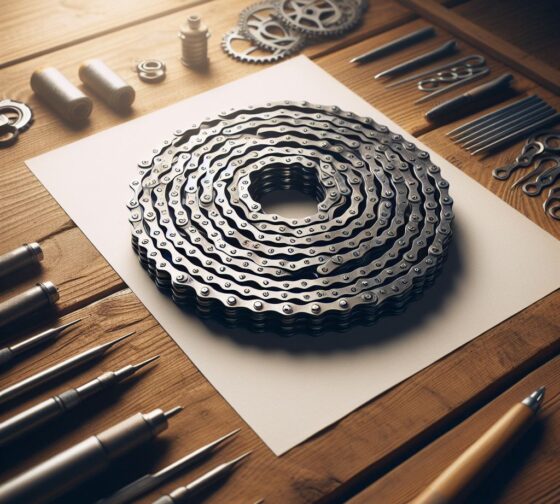Bike Chain Essentials: Navigating Your Cycling Journey
*We may earn a commission for purchases made using our links. Please see our disclosure to learn more.
Bike Chain Essentials: Understanding, Maintenance, and Upgrades
Bike chains, often overlooked for their intricacy, are marvels of engineering. They consist of a series of inner and outer links, pins, and rollers, each meticulously designed to function seamlessly and efficiently. Exploring the anatomy of a bike chain and understanding its components is crucial for every cyclist. Moreover, the market offers a plethora of chain types, tailored for various bike drivetrains, from single-speed to multi-speed systems. Knowing the differences and how they cater to specific biking needs empowers riders to make informed choices when selecting a chain.
As an avid cyclist, I’ve come to realize that a bike chain is more than just a link between the pedals and the wheels—it’s the heartbeat of a bicycle. It’s the silent hero that ensures a smooth, efficient ride, yet its significance often goes unnoticed until it encounters an issue. Let’s dive deeper into the realm of bike chains—unraveling their complexities, understanding their nuances, and learning how to ensure they’re in top-notch condition for a seamless cycling experience.
Choosing the Right Bike Chain

The process of selecting the right chain might seem trivial, but it holds immense importance. Compatibility with the bike’s drivetrain, the number of gears, and the chain’s width are critical factors. Ensuring the chain aligns perfectly with the bike’s specifications not only optimizes performance but also minimizes wear and tear. A mismatched chain can lead to inefficiencies, affecting the overall riding experience. Therefore, a thorough understanding of your bike’s drivetrain and the corresponding chain requirements is pivotal.
Here are my top three bike chain brands known for their quality, durability, and performance:
- Shimano: Shimano is a renowned brand in the cycling industry, offering a wide range of bike components, including high-quality bike chains. They produce chains suitable for various drivetrain systems, ensuring compatibility and reliability.
- SRAM: SRAM is another prominent name known for manufacturing top-notch bike chains. They provide chains designed for different levels of cycling, from casual riders to professional cyclists. SRAM’s chains are recognized for their durability and smooth shifting performance.
- KMC: KMC is recognized for its innovative technology and a diverse range of chains suitable for different bike types and riding styles. They offer durable, high-performance chains that cater to various drivetrain configurations, earning a strong reputation among cyclists.
These brands consistently prioritize research and development, focusing on enhancing the quality, performance, and longevity of their bike chains, making them among the most trusted options in the market.
Maintenance of Bike Chains
Regular maintenance is the cornerstone of extending a bike chain’s life. Cleaning and lubricating the chain are fundamental practices that prevent rust, corrosion, and premature wear. Consistency is key; setting a routine for cleaning and lubrication, ideally every 100-150 miles or when the chain appears visibly dirty, ensures optimal performance. Additionally, being vigilant about signs of wear, such as elongation or skipping, serves as an indicator for when it’s time to replace the chain. Tools like a chain checker aid in determining the wear limit, preventing unexpected malfunctions during rides.
Improving Bike Chain Longevity
Beyond routine maintenance, several practices contribute significantly to a chain’s longevity. Ensuring proper tension, avoiding extreme cross-chaining, and riding in clean conditions are simple yet impactful measures. Proper tension keeps the chain from bouncing and reduces wear on the drivetrain components. Similarly, avoiding extreme cross-chaining, where the chain is stretched to its limits, prevents excessive strain on the chain. Riding in clean conditions, free from dust and debris, reduces abrasive wear and tear, further enhancing the chain’s life.
Common Issues with Bike Chains
Despite meticulous care, bike chains can encounter various issues. From chain suck—a situation where the chain gets stuck between chainrings—to stiff links disrupting the smooth cycling motion, identifying and addressing these problems is essential. Knowing how to troubleshoot these issues, whether it’s through simple adjustments or seeking professional help, is crucial for maintaining a hassle-free riding experience.
Upgrading Your Bike Chain

As cycling proficiency grows, considering an upgrade becomes a natural progression. High-quality chains offer an array of benefits, including enhanced durability, smoother shifting, and improved overall performance during rides. Upgrading at the right time—when the current chain shows signs of wear beyond maintenance—is a strategic move. Investing in a superior-quality chain not only elevates the cycling experience but also ensures a reliable and efficient ride.
Conclusion
The bike chain, often underappreciated yet undeniably crucial, serves as the unsung hero of every cycling endeavor. It is not merely a link between components but a fundamental element dictating the smoothness, efficiency, and reliability of a ride. Understanding the nuances of bike chains, selecting the right one, maintaining it meticulously, and discerning the opportune moment for an upgrade significantly impact the overall cycling experience.
As cyclists, our relationship with the bike chain is symbiotic—it allows us to glide through our journeys effortlessly while relying on our care and attention for its sustained performance. By grasping the intricacies of these seemingly simple yet complex components, we equip ourselves to maximize the efficiency of our bikes, ensuring each ride is not just a journey but an exhilarating experience. The bike chain stands as a testament to the harmony between machinery and rider, encapsulating the essence of cycling as both an art and a science.
FAQs About Bike Chains
1. How often should I clean and lubricate my bike chain?
Regular cleaning and lubrication, ideally every 100-150 miles or when visibly dirty, help maintain optimal performance.
2. Can I use any bike chain for my bike?
No, selecting the right chain based on your bike’s drivetrain specifications is crucial for optimal performance and longevity.
3. How do I know when it’s time to replace my bike chain?
Signs such as elongation or skipping indicate wear. A chain checker tool assists in determining wear limits.
4. What are the benefits of upgrading to a high-quality bike chain?
Upgrading offers enhanced durability, smoother shifting, and improved overall performance during rides.
5. Are there specific techniques to prolong a bike chain’s life?
Avoid extreme cross-chaining, maintain proper tension, and ride in clean conditions to extend your bike chain’s life span.




